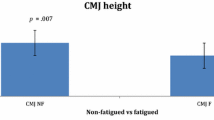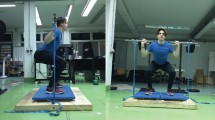Abstract
Introduction
The present study investigated associations between trunk muscle strength, jump performance, and lower limb kinematics during drop jumps on stable and unstable surfaces. Next to this behavioral approach, correlations were also computed on a neuromuscular level between trunk and leg muscle activity during the same test conditions.
Methods
Twenty-nine healthy and physically active subjects (age 23 ± 3 years) were enrolled in this study. Peak isokinetic torque (PIT) of the trunk flexors and extensors was assessed separately on an isokinetic device. In addition, tests included drop jumps (DJ) on a force plate under stable and unstable (i.e., balance pad on top of the force plate) surfaces. Lower limb kinematics as well as electromyographic activity of selected trunk and leg muscles were analyzed.
Results
Significant positive but small correlations (0.50 ≤ r ≤ 0.66, p < 0.05) were detected between trunk extensor PIT and athletic performance measures (i.e., DJ height, DJ performance index), irrespective of surface condition. Further, significant negative but small correlation coefficients were examined between trunk extensor PIT and knee valgus motion under stable and unstable surface conditions (−0.48 ≤ r ≤ −0.45, p < 0.05). In addition, significant positive but small correlations (0.45 ≤ r ≤ 0.68, p < 0.05) were found between trunk and leg muscle activity, irrespective of surface condition.
Discussion
Behavioral and neuromuscular data from this study indicate that, irrespective of the surface condition (i.e., jumping on stable or unstable ground), the trunk plays a minor role for leg muscle performance/activity during DJ. This implies only limited effects of trunk muscle strengthening on jump performance in the stretch-shortening cycle.

Similar content being viewed by others
Abbreviations
- EMG:
-
Electromyographic
- GRF:
-
Ground reaction force
- MAV:
-
Mean average voltage
- PIT:
-
Peak isokinetic torque
References
Anderson K, Behm DG (2005) Trunk muscle activity increases with unstable squat movements. Can J Appl Physiol 30(1):33–45
Arampatzis A, Stafilidis S, Morey-Klapsing G, Brüggemann G (2004) Interaction of the Human Body and Surfaces of Different Stiffness during Drop Jumps. Med Sci Sports Exerc 36(3):451–459
Baur H, Müller S, Pilz F, Mayer P, Mayer F (2010) Trunk extensor and flexor strength of long-distance race car drivers and physically active controls. J Sports Sci 28(11):1183–1187
Bressel E, Willardson JM, Thompson B, Fontana FE (2009) Effect of instruction, surface stability, and load intensity on trunk muscle activity. J Electromyogr Kinesiol 19(6):e500–e504
Coren S (1993) The lateral preference inventory for measurement of handedness, footedness, eyedness, and earedness: norms for young adults. Bull Psychon Soc 31(1):1–3
Desmedt JE, Godaux E (1977) Ballistic contractions in man: characteristic recruitment pattern of single motor units of the tibialis anterior muscle. J Physiol 264(3):673–693
Faul F, Erdfelder E, Lang A, Buchner A (2007) G*Power 3: a flexible statistical power analysis program for the social, behavioral, and biomedical sciences. Behav Res Methods 39(2):175–191
Frey I, Berg A, Grathwohl D, Keul J (1999) Freiburg Questionnaire of physical activity-development, evaluation and application. (Freiburg Questionnaire of physical activity–development, evaluation and application). Soz Praventivmed 44(2):55–64
Henneman E (1957) Relation between size of neurons and their susceptibility to discharge. Science 126(3287):1345–1347
Hermens HJ, Merletti R, Freriks B (1999) SENIAM: European recommendations for surface electromyography results of the SENIAM project, 2nd edn. Roessingh Research and Development, Enschede
Hodges PW, Richardson CA (1997) Contraction of the abdominal muscles associated with movement of the lower limb. Phys Ther 77(2):132–142
Jamison ST, McNeilan RJ, Young GS, Givens DL, Best TM, Chaudhari AMW (2012) Randomized controlled trial of the effects of a trunk stabilization program on trunk control and knee loading. Med Sci Sports Exerc 44(10):1924–1934
Jamison ST, McNally MP, Schmitt LC, Chaudhari AM (2013) The effects of core muscle activation on dynamic trunk position and knee abduction moments: implications for ACL injury. J Biomech 46(13):2236–2241
Keogh JWL, Aickin SE, Oldham ARH (2010) Can common measures of core stability distinguish performance in a shoulder pressing task under stable and unstable conditions? J Strength Cond Res 24(2):422–429
Kibele A (1999) Technical Note: possible errors in the comparative evaluation of drop jumps from different heights. Ergonomics 42(7):1011–1014
Kibler WB, Press J, Sciascia A (2006) The role of core stability in athletic function. Sports Med 36(3):189–198
Komi PV, Gollhofer A (1997) Stretch reflexes can have an important role in force enhancement during SSC exercise. J Appl Biomech 13(4):451–459
Milner-Brown HS, Stein RB, Yemm R (1973) The orderly recruitment of human motor units during voluntary isometric contractions. J Physiol 230(2):359–370
Myer GD, Brent JL, Ford KR, Hewett TE (2008) A pilot study to determine the effect of trunk and hip focused neuromuscular training on hip and knee isokinetic strength. Br J Sports Med 42(7):614–619
Myer GD, Ford KR, Brent JL, Hewett TE (2012) An integrated approach to change the outcome part I: neuromuscular screening methods to identify high ACL injury risk athletes. J Strength Cond Res 26(8):2265–2271
Nesser TW, Huxel KC, Tincher JL, Okada T (2008) The relationship between core stability and performance in division I football players. J Strength Cond Res 22(6):1750–1754
Okada T, Huxel KC, Nesser TW (2011) Relationship between core stability, functional movement, and performance. J Strength Cond Res 25(1):252–261
Prieske O, Muehlbauer T, Mueller S, Krueger T, Kibele A, Behm DG, Granacher U (2013) Effects of surface instability on neuromuscular performance during drop jumps and landings. Eur J Appl Physiol 113(12):2943–2951
Prieske O, Muehlbauer T, Krueger T, Kibele A, Behm DG, Granacher U (2014) Sex-specific effects of surface instability on drop jump and landing biomechanics. Int J Sports Med 35 (accepted)
Saeterbakken AH, Fimland MS (2013) Muscle Force Output and Electromyographic Activity in Squats With Various Unstable Surfaces. J Strength Cond Res 27(1):130–136
Sharma A, Geovinson SG, Singh Sandhu J (2012) Effects of a nine-week core strengthening exercise program on vertical jump performances and static balance in volleyball players with trunk instability. J Sports Med Phys Fit 52(6):606–615
van Ingen Schenau GJ, Bobbert MF, Rozendal RH (1987) The unique action of bi-articular muscles in complex movements. J Anat 155:1–5
Vincent WJ (1995) Statistics in kinesiology. Human Kinetics, Champaign
Willson JD, Dougherty CP, Ireland ML, Davis IM (2005) Core stability and its relationship to lower extremity function and injury. J Am Acad Orthop Surg 13(5):316–325
Zazulak BT, Hewett TE, Reeves NP, Goldberg B, Cholewicki J (2007) Deficits in neuromuscular control of the trunk predict knee injury risk: a prospective biomechanical-epidemiologic study. Am J Sports Med 35(7):1123–1130
Acknowledgments
The authors would like to thank the University Outpatient Clinic of the University of Potsdam for allowing us to use the isokinetic dynamometer Con-Trex TP1000. No sources of funding were used to assist in the preparation of this study.
Conflict of interest
The authors have no conflicts of interest that are directly relevant to the content of this study.
Author information
Authors and Affiliations
Corresponding author
Additional information
Communicated by Fausto Baldissera.
Rights and permissions
About this article
Cite this article
Prieske, O., Muehlbauer, T., Krueger, T. et al. Role of the trunk during drop jumps on stable and unstable surfaces. Eur J Appl Physiol 115, 139–146 (2015). https://doi.org/10.1007/s00421-014-3004-9
Received:
Accepted:
Published:
Issue Date:
DOI: https://doi.org/10.1007/s00421-014-3004-9




